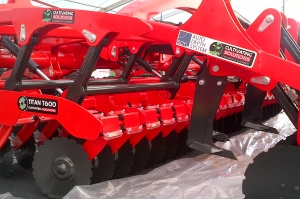Variable rate cultivations technology developed
A collaboration between two LAMMA-award winning companies will offer farmers the opportunity to use variable rate cultivations to cut costs and improve weed control.

SOYL is working with Yorkshire tillage equipment manufacturer Cultivating Solutions. Together, they are developing control systems for the Titan Power Drive and RapidLift cultivator to vary the working depth of soil loosening tines according to information from soil or weed maps. SOYL won the IVEL Award for the product or innovation which has the most positive impact on the environment at LAMMA 2013 for its variable rate cultivations technology, while Cultivating Solutions’ Titan Power Drive received a certificate of merit for best new product or innovation in the over £10,000 category.
SOYL has developed the technology to adjust the working depth of soil loosening legs on a cultivator according to compaction maps produced by using its compaction mapping service SubSOYL. In its development phase, the depth control unit, Autodepth, regulated the length of the cultivators hydraulic ram to automatically adjust the height of the roller and thus alter the working depth of the subsoiling leg. This is done by calculating the required distance between a sensor on the subsoiler headstock and the plate on the end of the ram to lift or lower the roller.
SOYL was assisted in the project by machinery importer Opico which mounted the unit on its HeVa subsoiler. It was successfully trialled on farms last year and the recent collaboration with Cultivating Solutions will enable customers to specify the Autodepth system to be factory fitted to new machines.
Cultivating Solutions’ Titan Power Drive combination cultivator features a powered rear packer rollerwhich offers fuel savings along with low disturbance loosening legs and cultivating discs. All elements can be raised or lowered individually to suit conditions.
RapidLift is a drill-mounted low disturbance soil loosening implement which can also be used to combine the benefits of soil loosening and the increased accuracy of a drill when establishing oilseed rape.
RapidLift is also available in fully mounted format (RLM) with a rear towing hitch to allow for towing implements such as a cultivator or drill. The RLM remains at a fixed height on the rear linkage and rear hitch and the low disturbance loosening legs raise and lower independently, therefore not affecting the height of the following implement.
SOYL's agricultural development manager David Whattoff explains: “We entered discussions with Cultivating Solutions who were already working on low disturbance cultivation systems and it became clear that their managing director, Richard Scholes, could see the potential for reduced depth cultivations, directed by application maps generated by SOYL.”
“Cultivating Solutions and SOYL have a number of mutual customers who are progressive farmers seeking to increase efficiency through a high level of precision. After variable rate fertiliser and seeding, increasing the precision of cultivations is a logical step,” comments Richard Scholes.
“An area of particular interest is blackgrass control. Avoiding mixing the layers of soil helps to keep blackgrass seeds on the surface where they will germinate for easier control and this is effectively achieved by less aggressive loosening.”
Reducing the horsepower and therefore fuel consumption required to move the machine across the field is an additional benefit.
“Low disturbance soil loosening legs cut fuel costs in any case and this effect will be enhanced by only working at depth where it is necessary.”
The design of the implements already allowed the operator to alter the working depth of the loosening leg from the tractor cab via a hydraulic parallelogram on the frame and it was easily automated, suggests Mr Scholes.
He adds: “Soil loosening legs can be set to any position, from being completely out of work to a depth of up to 300mm, so maximum and minimum parameters can be set to suit the conditions and requirements of the user.”
The depth control unit now uses a potentiometer rather than an acoustic sensor to measure the angle of the discs or tines, but the changeover has otherwise been seamless, reports Mr Whattoff.
SOYL has invested in UAV (drone) technology which can map weeds for treatment and can subsequently be used to assess the effect of the operation.
SOYL customers can access their compaction, soil texture and weed population maps via the company’s website portal MySOYL and can generate cultivation plans used to control the implement.
“It will be possible to fine tune the maps to suit farmers’ needs and they can also ‘nudge’ cultivation depth from the cab, for example if a wet patch of field is encountered,” explains Mr Whattoff.
“We have launched Titan Power Drive and RapidLift machines with the variable rate control unit as pre-production models at LAMMA 2014 and will continue with development work this year,” explains Mr Scholes.
The control unit can also be retrofitted to existing RapidLift and Titan machines and will be offered as an option on new implements.
Mr Scholes concluded: “We expect the greatest uptake to be on the RapidLift and believe there is great potential to increase margins, particularly for oilseed rape. It’s a good opportunity for SOYL customers to get even more out of their maps for a comparatively small investment.”










